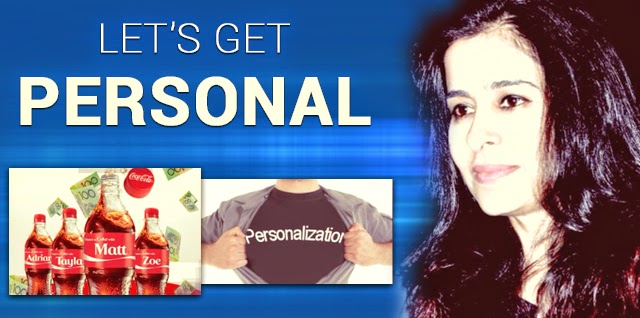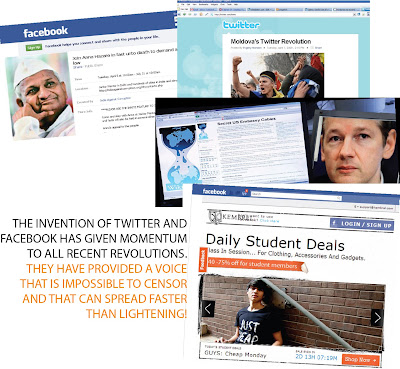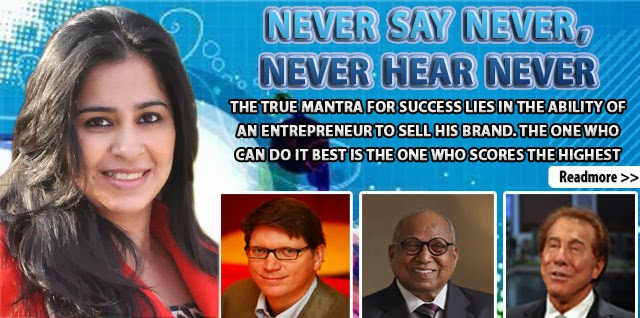LET’S GET PERSONAL
More than forty years ago, Peter Drucker had said, "The aim of marketing is to know and understand the customer so well that the product or service fits him or her and sells itself."
The key words here are ‘know and understand the customer’. Never in the history of marketing has this point been more important than now and never has it been easier to know and understand a customer than now! The relation is simple – the better you know them, the better you can serve them and the lesser you need to market to them. Personalization is nothing new to business. A lot of companies have been following this business strategy for a very long time.
Take the case of Dell. It’s been personalizing its computers for decades. Nike and Adidas allow customers to design their own shoes; the BMW Mini has a facility where customers can design the roof of their car online and it will be made accordingly. Even banks are giving customers the option to design their cheque books and credit cards. Ikea lets you customize your furniture.
Extreme Personalization
Personalization is not something new. Marketers have been practicing it for long. However, mere personalization will not suffice this time for now is the era of ‘extreme personalization’. Sephora is one such beauty brand that has found how personalization reflects directly on the balance sheets. It has a loyalty program named ‘Beauty Insider’ which can define your skin tone and show you a list of products that match it. Once the customer becomes a part of this program, her profile can be accessed through the mobile or desktop or even the iPad at the store. This makes the job of the salesperson much easier as she knows which products would suit the customer best. The customer goes back satisfied and sure that she has got the best match.
The key words here are ‘know and understand the customer’. Never in the history of marketing has this point been more important than now and never has it been easier to know and understand a customer than now! The relation is simple – the better you know them, the better you can serve them and the lesser you need to market to them. Personalization is nothing new to business. A lot of companies have been following this business strategy for a very long time.
Take the case of Dell. It’s been personalizing its computers for decades. Nike and Adidas allow customers to design their own shoes; the BMW Mini has a facility where customers can design the roof of their car online and it will be made accordingly. Even banks are giving customers the option to design their cheque books and credit cards. Ikea lets you customize your furniture.
Extreme Personalization
Personalization is not something new. Marketers have been practicing it for long. However, mere personalization will not suffice this time for now is the era of ‘extreme personalization’. Sephora is one such beauty brand that has found how personalization reflects directly on the balance sheets. It has a loyalty program named ‘Beauty Insider’ which can define your skin tone and show you a list of products that match it. Once the customer becomes a part of this program, her profile can be accessed through the mobile or desktop or even the iPad at the store. This makes the job of the salesperson much easier as she knows which products would suit the customer best. The customer goes back satisfied and sure that she has got the best match.
Pizza Hut asks customers to speak to it. The company asks them to fill up a form with their preferences and delivery instructions. Pizza Hut now knows which pizzas are in demand and can plan special deals and offers for its customers. They can also ‘reorder’ their last order or pre-order up to 7 days. So if Saturday is your ‘junk food’ day, you can plan it way ahead and Pizza Hut would know exactly which pizza you would want. A 38% increase in customer retention rates, a 9% increase in purchase frequency and a 6% extra sale generated every month, is the advantage of going personal for Pizza hut. All this has been possible because Pizza Hut runs more than seventeen thousand campaigns online. Each one designed to target a specific and very niche set of consumers.
Swisscom is another company that takes things personally!! Every communication with the customer is recorded, analysed using analytics and software models; numerous personalized campaigns are developed for these customers, making the user more involved and more loyal to the brand. Not surprising, it is the largest telecom company in Switzerland.
Successful restaurants are finding how a little bit of personalization can reap rich dividends. Danny Meyer is an entrepreneur who has launched more than 10 successful restaurants and he says that when he adds a dash of personalization, he wins the loyalty of his customers. He says that if his data shows that the customer usually orders a $100 bottle of pinot noir, then he instructs his staff to keep one bottle ready when the customer visits his restaurant, and more than that to make sure that when they suggest wines to him, they should never suggest the $1000 bottle of Chardonnay. It’s these little things that will bring back the customer to you every time.
Brands like Sephora, Swisscom etc have a crystal clear image of who their customer is and what he wants. These brands have a higher engagement level with their consumers so their attrition rates are lower and consequently their customers are more satisfied than others. This has been possible because of the vast data that we all have access to nowadays. The surprising part is not many brands are paying attention to this data. The few who are, are reaping rich dividends.
EGOnomics
It’s all about ego. Most relationship experts will tell you that getting a job well done consists largely of managing the egos of the team members intelligently. The new rule of success in business will be the ability to satisfy the egos of your people –consumers, employees and other partners and stakeholders of your business. Business has to be done on their (read consumers’) terms.
The first concept, EGOnomics, was coined by Faith Popcorn, who said: "To offset a depersonalized society, consumers crave recognition of their individuality." Thus they would always be attracted to a brand a company that offered them something more than the standard and which made them feel more involved. They would be loyal to the brand that listens to them and talks to them.
The brand which makes interaction between the customers and itself the easiest and most satisfying is the one that will land up with the largest market share. The key differentiator will be the ease with which they are ale to interact with your brand.
A pharmacy will not just be responsible for keeping medicines but also keeping records of the prescriptions of its customers and keep track of the time when they need a refill. Don’t expect the customer to come back; rather, remind him it’s time to buy the prescribed dose. The customer will never ever dream of going anywhere else.
Pamper him spoil him and he will repay you with his loyalty. Know him so well that you already have something ready for him even before he asks you.
We live in a world where instant gratification is the way of life and technology has made it all the more easy. You can forget queues and deposit cheques online, shop online, date online, make friends online… And the list goes on. Brands that help us with this ‘instant gratification’ process are the ones who are the biggest brands now days or will soon be.
The newest and perhaps the biggest P of marketing is ‘Personalization’. In fact, it’s this ‘P’ that will soon make the 4Ps of marketing (given by Kotler in 1960s) redundant. The new rules of marketing will be
1) Identify: You need to know who is your customer.
2) Individualization: Understand each customer’s specific needs.
3) Interact: Once you know his needs, you start interacting with him and getting to know him better.
4) Integrity: As you get to know him better, he too starts learning about you and starts trusting you. Once he does that, you have found a customer for life.
Look at Airbnb. It’s a new brand and yet it’s giving almost all hotel chains tough competition. The business model of Airbnb is very simple. It has built a network of people who are interested in renting out their homes to strangers. The agreement works only when both the parties trust each other. In today’s hyper connected world, everybody has an online identity and a reputation; so it was relatively easy to build trust. Moreover, to use the services of Airbnb, you have to fill a detailed profile of yours, complete with passport details, Facebook, Linkedin profiles etc. What Airbnb did which most others did not was to get to know its users and match the service specifically to each one’s requirements. Soon, Airbnb will not just be providing rented homes for tourists to stay but also be giving them information about the local cuisine, which it thinks they would be interested in, local theaters , local shopping destinations which would match the profile of the user. Who would want to stay in an impersonalized 5 star when this can be so much fun!
Not surprising that on the night of the Brazil vs. Germany World Cup Football semifinal match, more than 150 Germans stayed with Brazilians in their homes –courtesy Airbnb.
This is the new world.
Tag and be tagged
We all love personalization, and today, technology has made it possible to achieve very high degrees of customization. With 3D printers becoming popular by the day, the whole buying process and experience is going to change forever. There are companies that are already enjoying the fruits of this innovation. Protos Eyewear now makes customized 3D printed eyeglasses.
Another big leap in customer buying experience will be because of Big Data analytics. Thanks to the wide spread popularity of smart phones which are constantly processing huge amounts of data, the soon to be popular wearable devices (the most stylish and promising one being the Apple watch) would have so much data about so many people and so many things that it’s unimaginable. The brand Monsoon has found an innovative way to share data with you. It sends its customers messages informing them of the status of its inventory, so you know which design is running out and will be soon out of stock and accordingly plan your shopping trip.
Not just this; the future will be the ‘Internet of Things’ (IoT) which in simple terms means every device will come embedded with a sensor, a chip that will send information to a server and keep you informed. IoT is a case where, in the future, everything will be tagged – people, animals, things (It’s estimated that by 2020, there will be 15 billion things connected to the internet and each other).
They will have the ability to send data over a network without requiring human or computer intervention. The data would also be processed and analyzed automatically with the help of software.
So the IoT will help a company manufacturing elevators to predict beforehand if the lift will breakdown, as the chips will keep sending information to a central server about the condition of the wires, the machinery inside. So the moment it spots critical wear and tear, which could lead to a breakdown, the chip will send a signal which will be picked up by the nearest service station; and soon, the repairman would be there to fix it – even before it broke. Similarly, a chip in your pacemaker would send a signal to your doctor if it senses something wrong, and he would call you for a checkup before you even felt the discomfort! Amazing!
This ‘Big data’ will guide all future marketing operations. It will help you find a whole lot of details about your customers and you would be expected to make a campaign customized specially for him. The more customized and personalized it is, the more effective will your communication be and the more loyalty you will earn.
Advertising and marketing will no longer be about mass-communication where one message, one advertisement, one promotion plan, one discount rate was planned for everybody. Now, with technology and access to the most detailed data ever possible about your customer, as a marketer it will be expected that you almost handcraft your product or service to suit the whims and fancies of your customer. The one who does it best will be the leader of the future. The market size of your product is now going to be ‘ONE’. Businesses will now have to serve individuals and one-to-one marketing will reinvent the whole business.
However, in this run for personalization, the best personal experience will still come from the human touch. We may want a lot of things but the strongest need will be the need to be loved, to be wanted, to make someone smile, to just have fun with friends, to have a loving family. No phone, however smart it is, can do that.
The world of business will soon be about you and will focus on you; but your world should always be about ‘them’ – your family, your friends your people.
So as the final word goes, to get rich both in the heart and the bank, get personal.



Comments
Post a Comment